 On March 7 one of my favorite bloggers, Kevin Drum, passed away from a longtime fight with cancer. To say he will be sorely missed is great understatement. From my limited perspective, his was the last of the original type of weblog, namely one written by a single person with multiple postings per day. And his perspective was unique. It was the only blog I’ve seen that largely concentrates on data analysis of economics, science, medicine, societal trends, and on and on, in a clear, succinct, and informative manner. The text is further supported with simple graphs that provide visual clarity to the analysis.
On March 7 one of my favorite bloggers, Kevin Drum, passed away from a longtime fight with cancer. To say he will be sorely missed is great understatement. From my limited perspective, his was the last of the original type of weblog, namely one written by a single person with multiple postings per day. And his perspective was unique. It was the only blog I’ve seen that largely concentrates on data analysis of economics, science, medicine, societal trends, and on and on, in a clear, succinct, and informative manner. The text is further supported with simple graphs that provide visual clarity to the analysis.
Elusive Angle
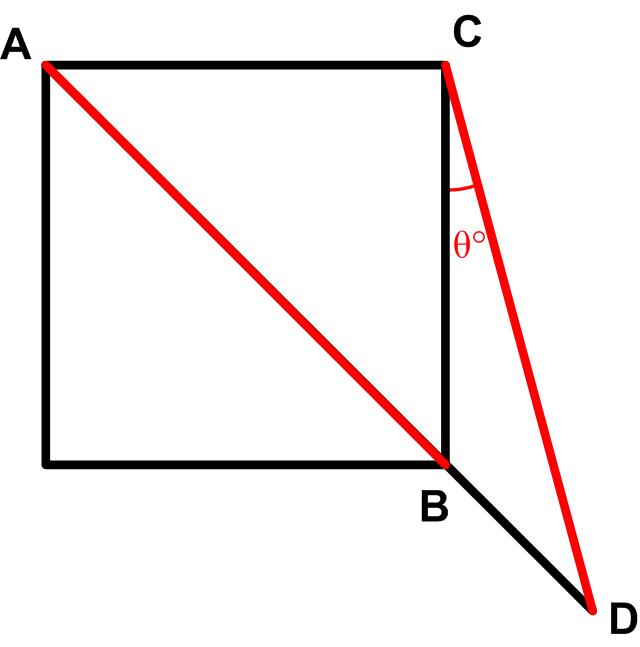 For me this turned out to be sort of a challenging problem from the 2025 Math Calendar.
For me this turned out to be sort of a challenging problem from the 2025 Math Calendar.
“Given equal line segments AB = CD, what is angle θ in degrees?”
See Elusive Angle for a solution
Circular Ant Problem
 This is a wicked variation of the ant problem on a stick by Peter Winkler.
This is a wicked variation of the ant problem on a stick by Peter Winkler.
“Twenty-four ants are randomly placed on a circular track of length 1 meter; each ant faces randomly clockwise or counterclockwise. At a signal, the ants begin marching at 1 cm/sec; when two ants collide they both reverse directions. What is the probability that after 100 seconds, every ant finds itself exactly where it began?”
See Circular Ant Problem for solutions.
Tricky Triangle
 I think this turned out to be an even trickier problem than Alex Bellos thought.
I think this turned out to be an even trickier problem than Alex Bellos thought.
“Tricky triangle This one was sent in by a reader, aged 85, who first saw it in 1960. He is a roboticist who passed through Harvard, Princeton, Stanford and IBM. He says it is his favourite puzzle. ‘I’ve given this puzzle to perhaps 100 people. Over 80% have no idea how to solve it.’ What is the length of AD, the dashed line?”
See Tricky Triangle for solutions.
Cat and Mice
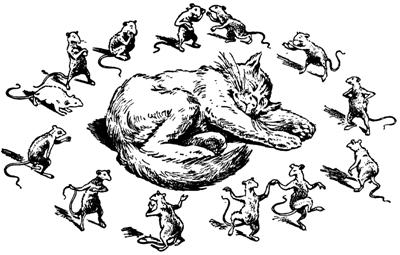 This is a classic puzzle from Boris Kordemsky’s 1972 Moscow Puzzles.
This is a classic puzzle from Boris Kordemsky’s 1972 Moscow Puzzles.
“Purrer has decided to take a nap. He dreams he is encircled by 13 mice: 12 gray and 1 white. He hears his owner saying: “Purrer, you are to eat each thirteenth mouse, keeping the same direction. The last mouse you eat must be the white one.” Which mouse should he start from [eat first]?”
See Cat and Mice for a solution.
The Josephus Problem
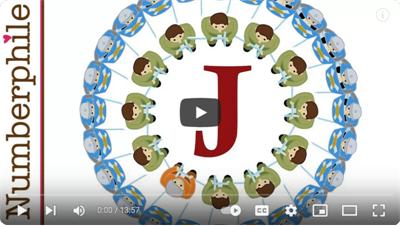 This famous Josephus Problem presented on Youtube is somewhat different from the Cat and Mice puzzle, but still has similarities. An article by Jay Bennett discussing the problem was published in Popular Mechanics in 2016.
This famous Josephus Problem presented on Youtube is somewhat different from the Cat and Mice puzzle, but still has similarities. An article by Jay Bennett discussing the problem was published in Popular Mechanics in 2016.
Penn and Teller – Spelling Cards
 It turns out that Penn and Teller have performed another magic trick recently that is based on mathematical principles and so is more or less self-working. It is a more complicated version of the Cat and Mice puzzle, which I have dubbed the “Spelling Cards” trick. Continue reading
It turns out that Penn and Teller have performed another magic trick recently that is based on mathematical principles and so is more or less self-working. It is a more complicated version of the Cat and Mice puzzle, which I have dubbed the “Spelling Cards” trick. Continue reading
Fill in the Blanks
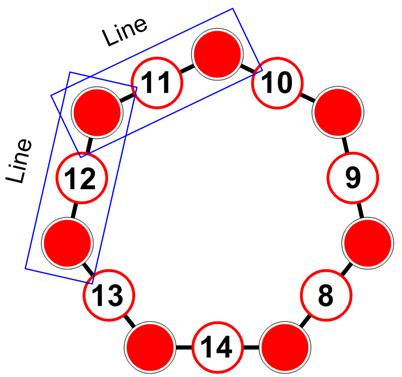 This is a fun puzzle from John Bassey at Puzzle Sphere.
This is a fun puzzle from John Bassey at Puzzle Sphere.
“The diagram shows a heptagon with three circles on each side. Some circles already have the numbers 8 to 14 filled in, while the remaining circles need to be filled with the numbers 1 to 7. Each circle must contain one number, and the sum of the numbers in every set of three circles along a line must be the same. Arrange the numbers!!!”
See Fill in the Blanks for a solution.
Chinese Quadrilateral Puzzle
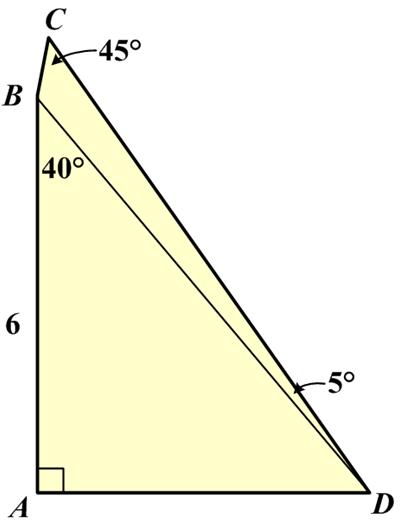 This is another intimidating puzzle from Presh Talwalkar:
This is another intimidating puzzle from Presh Talwalkar:
“Thanks to Eric from Miami for suggesting this problem and sending a solution!
From a 5th grade Chinese textbook: In the quadrilateral ABCD, angle A = 90°, angle ABD = 40°, angle BDC = 5°, angle C = 45°, and the length of AB is 6. Find the area of the quadrilateral ABCD.”
See the Chinese Quadrilateral Puzzle for solutions.
Ubiquitous 60 Degree Problem
 This is an interesting problem from the Canadian Mathematical Society’s 2001 Olymon.
This is an interesting problem from the Canadian Mathematical Society’s 2001 Olymon.
“Suppose that XTY is a straight line and that TU and TV are two rays emanating from T for which XTU = UTV = VTY = 60º. Suppose that P, Q and R are respective points on the rays TY, TU and TV for which PQ = PR. Prove that QPR = 60º.”
See the Ubiquitous 60 Degree Problem
Martin Luther King Day 2025
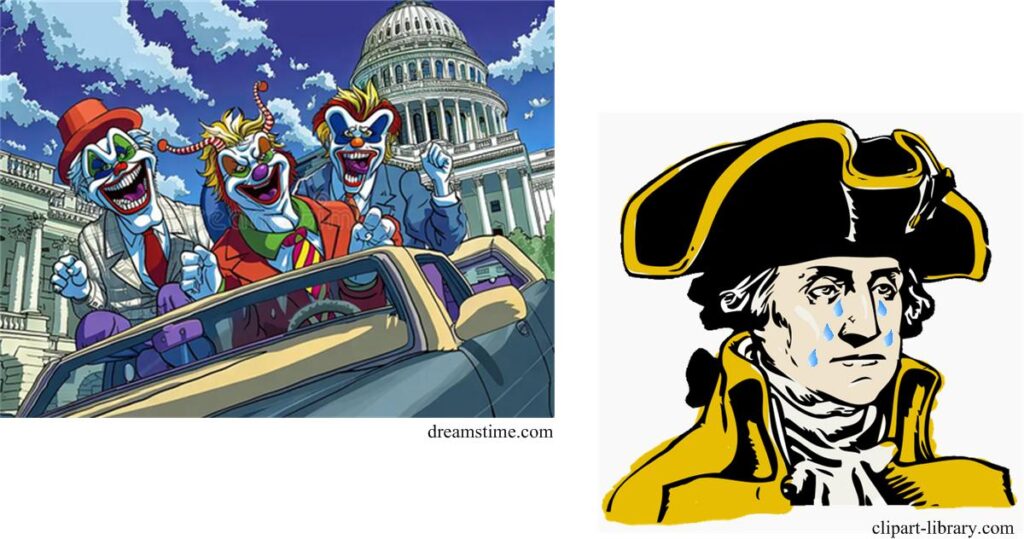
From Futility Closet:
A Lesson
John Alexander Smith, Waynflete Professor of Moral and Metaphysical Philosophy at Oxford, opened a course of lectures in 1914 with these words:
“Gentlemen — you are now about to embark upon a course of studies which will occupy you for two years. Together, they form a noble adventure. But I would like to remind you of an important point. Some of you, when you go down from the University, will go into the Church, or to the Bar, or to the House of Commons, to the Home Civil Service, to the Indian and Colonial Services, or into various professions. Some may go into the Army, some into industry and commerce; some may become country gentlemen. A few — I hope a very few — will become teachers or dons. Let me make this clear to you. Except for the last category, nothing that you will learn in the course of your studies will be of the slightest possible use to you in after life — save only this — that if you work hard and intelligently you should be able to detect when a man is talking rot, and that, in my view, is the main, if not the sole, purpose of education.”
See Martin Luther King Day for a PDF version.
Tire Wear
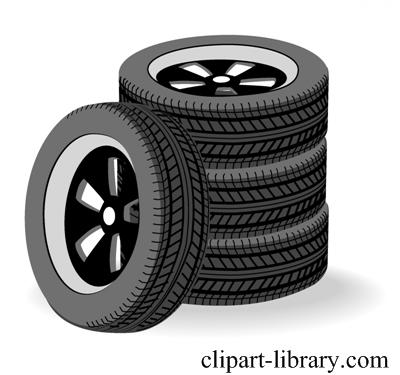 Thanks to Futility Closet I discovered a new source of math puzzles: A+Click.
Thanks to Futility Closet I discovered a new source of math puzzles: A+Click.
“A+ Click helps students become problem solvers. Free, without ads, no calculators, and without signing-up. The website features a graduated set of 16,000+ challenging problems for students in grades one through twelve, starting from the very simple to the extremely difficult. … The questions concentrate on understanding, spatial reasoning, usefulness, and problem solving rather than math rules and theorems. The problems include a short description and an illustration to help problem solvers visualize the model. The problems can be solved within one minute and without using a calculator.”
My only quibble with “The questions concentrate on understanding, spatial reasoning, usefulness, and problem solving rather than math rules and theorems.” is that by keeping explicit math notation and concepts to a minimum, the use of symbolic algebra and calculus is muted and there is a whiff of the medieval reliance on mental verbal agility rather than the power of the new mathematics.
Still the problems are imaginative and challenging. Here is a good example.
“The rear tires of my car wear out after 40,000 miles, while the front tires are done after 20,000 miles. Estimate how many miles I should drive before the tires (front and rear) are rotated to drive the maximal distance.
Answer Choices: 15,000 miles 12,000 miles 13,333 miles 16,667 miles”
(I admit solving these under a minute is a challenge, at which I often failed. Ignoring time constraints allows for greater care and a more thorough mulling over the intricacies of the problem. Yes, those who have mastered math can solve problems faster than those who have not, but real mastery of math requires an inordinate attention to details, and that requires time.)
See Tire Wear for solutions.
